
Communications
System and Message Overviews
Document Version: 1.11
Date: October 25, 2018
Document Revision History
The following revision history table reflects all substantive changes to this document.
| Date | Description of Updates Made |
31-July-10 |
Initial publication of document. |
30-August-10 |
Updated links for new Bookshelf directory structure. |
7-October-10 |
Updated XSD. Updated messages CM001, CM002, CM004. |
| 23-July-13 | Updated XSD. |
| 3-March-13 | New XSD. |
| 3-March-16 | New XSD. * Updated CM003 to version 2: Updated to support 702A status from aircraft fms or pilot: ack, acc, rej, or error conditions from flight plan message handler. Added uniqueId to aid in DFIS 702A message conversations. * Updated CM004 to version 2: Used in NMT as an alert. Added optional, string elements: icaoFormattedText, simpleFormattedText, companyFormattedText, eNotamFormattedText to CM004 publish, ND003 response, AN003 Publish messages. |
| 1-May-18 | New XSD. * Update CM004 version number in annotations to version 2. |
| 25-October-18 | New XSD. * Updated CM004 to version 3, Added element to output 633-2 basic and/or 633-2 extended xml, optional. |
Table Of Contents
1 Introduction
This document defines the interfaces which govern the interchange of data between a Communications system and other systems within an Airline Operation Center (AOC). Each AOC interface is represented by a message described in an associated XSD (XML Schema Definition). The XSD defines and enforces the required, optional, and conditional data that can be included in a message.
1.1 Audience
The intended audience for this document includes existing and potential Jeppesen customers, integration partners, and personnel with roles associated with application architecture, application development, system testing, implementation, and application support of applications within an Airline Operation Center.
1.2 Scope
This document discusses the Communications messages currently supported by the Jeppesen Solution Integrator. Each message description includes the following:
- Overview for common message uses within an AOC
- Message Version Summary listing all available versions of each message
- Links to the message specifications including direct links to XSD documentation, where you can explore the XSD hierarchy and interface specifications in a navigable HTML format
- Links to the XSD source code
- Links to sample XML messages for each AOC message
Other data interfaces or formats not included in this document will be considered custom and not supported.
1.3 XML Schema/XSD
The XML schema for this ICD is published in the following file: Communications.xsd
2 Message Summary
Table 2-1 lists the messages that can be sent or handled by the application. The messages originated by this application (messages that begin with “CM”) are further discussed in Section 3 AOC Interface Messages.
Table 2-1 Message Summary
| ID | Message |
Publish |
Subscribe |
Request |
Response |
CM001 |
Text Message From Aircraft |
X |
|
|
|
CM002 |
Text Message To Aircraft |
X |
|
|
|
CM003 |
ACARS Message Acknowledged |
X |
|
|
|
CM004 |
Send AdHoc Message |
X |
|
|
|
CM005 |
Ack AdHoc Fax Message |
X |
|
|
|
3 AOC Interface Messages
The following messages are processed by the Communications system.
3.1 CM001 - Text Message From Aircraft (ACARS downlink free text message)
3.1.1 Message Overview
This message is used to send a free form text message originating from an ACARS message through AOCi to a Dispatch system. The typical information flow is as follows:
- Aircraft sends free text ACARS message.
- ACARS message is ret rived by a receiver on the ground (for example, Arinc).
- Message is forwarded to external system, which translates the information into the AOCi CM001 message format.
- CM001 is forwarded through AOCi to the receiving Dispatch application.
3.1.2 Message System Flow
This message interacts with the systems as shown in Figure 1.
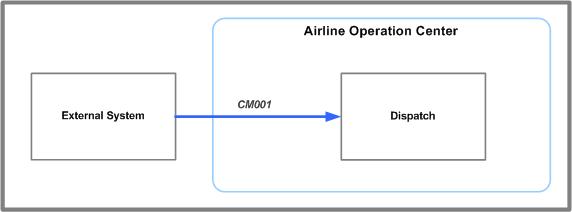
Figure 1. CM001 message system flow
3.1.3 Message Details
The following table provides details on the message version and includes links to the message’s technical specification.
Message Version |
CM001 v1 |
Message Header Details |
msgName: CM001 |
Message Specification |
|
Defined in XSD |
|
Sample Messages |
|
| Message Version History | Updated message. |
3.2 CM002 - Text Message To Aircraft (ACARS uplink text message)
3.2.1 Message Overview
This message is used to send a free form text message originating from a ground-based Dispatch system through AOCi to an aircraft as an ACARS message. The typical information flow is as follows:
- Dispatcher sends CM002 message containing the free form text through AOCi.
- AOCi sends the message through an external system, which translates the information into an ACARS format.
- ACARS message is sent to the aircraft via a ground-based transmitter (for example, Arinc).
3.2.2 Message System Flow
This message interacts with the systems as shown in Figure 2.
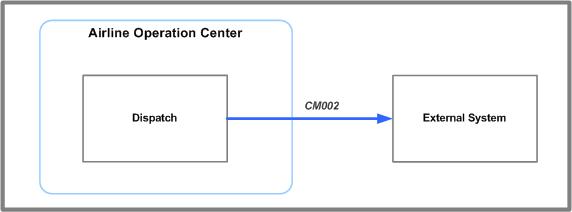
Figure 2. CM002 message system flow
3.2.3 Message Details
The following table provides details on the message and includes links to the message’s technical specification.
Message Version |
CM002 v1 |
Message Header Details |
msgName: CM002 |
Message Specification |
|
Defined in XSD |
|
Sample Messages |
|
| Message Version History | Updated message. |
3.3 CM003 – ACARS Message Acknowledged (Acknowledgement downlink message)
3.3.1 Message Overview
This message is used to acknowledge that a message was received by an aircraft. When the aircraft receives a ground-based message (for example, CM002), they can send this message back through the ACARS system to the Dispatcher.
3.3.2 Message System Flow
This message interacts with the systems as shown in Figure 3.
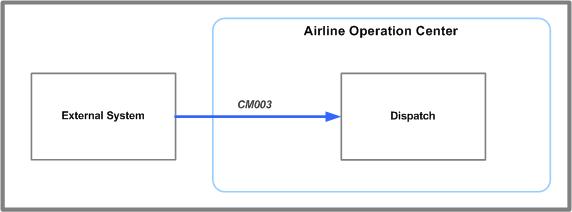
Figure 3. CM003 message system flow
3.3.3 Message Details
The following table provides details on the message and includes links to the message’s technical specification.
Message Version |
CM003 v2 |
Message Header Details |
msgName: CM003 |
Message Specification |
|
Defined in XSD |
|
Sample Messages |
Sample message not yet available |
| Message Version History | Version 2: |
3.4 CM004 – Send AdHoc Message (Send Message via address book)
3.4.1 Message Overview
This message is used to send a message to a recipient in an address book. The address can be a fax number, Arinc address, Sita address, or email address.
3.4.2 Message System Flow
This message interacts with the systems as shown in Figure 4.
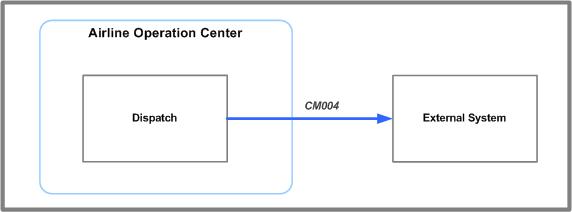
Figure 4. CM004 message system flow
3.4.3 Message Details
Message Version |
CM004 v3 |
Message Header Details |
msgName: CM004 |
Message Specification |
|
Defined in XSD |
|
Sample Messages |
Sample message not yet avaialble |
| Message Version History |
Version 2:
* Used in NMT as an alert. Added optional, string elements: icaoFormattedText, simpleFormattedText, companyFormattedText, eNotamFormattedText to CM004 publish, ND003 response, AN003 Publish messages. * Update version number in annotations to version 2. Version 3: * Updated CM004 to version 3, Added element to output 633-2 basic and/or 633-2 extended xml, optional. |
3.5 CM005 – Ack AdHoc Fax Message (Acknowledgement of Fax Message)
3.5.1 Message Overview
This message is used to notify a Dispatch application that an external system has successfully received a Fax. This message is often used in conjunction with the CM004 message, when the addressBookType is faxNumber
3.5.2 Message System Flow
This message interacts with the systems as shown in Figure 5.
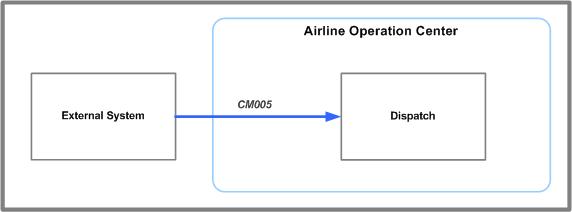
Figure 5. CM005 message system flow
3.5.3 Message Details
Message Version |
CM005 v1 |
Message Header Details |
msgName: CM005 |
Message Specification |
|
Defined in XSD |
|
Sample Messages |
|
| Message Version History | Initial publication of message. |